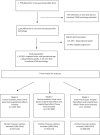The impact of the introduction of intrapartum fetal ECG ST segment analysis. A population study
- PMID: 35288935
- PMCID: PMC9564625
- DOI: 10.1111/aogs.14347
The impact of the introduction of intrapartum fetal ECG ST segment analysis. A population study
Abstract
Introduction: ST segment analysis (STAN) of the fetal electrocardiogram was introduced as an adjunct to cardiotocography for intrapartum fetal monitoring 30 years ago. We examined the impact of the introduction of STAN on changes in the occurrence of fetal and neonatal deaths, Apgar scores of <7 at 5 min, intrapartum cesarean sections, and instrumental vaginal deliveries while controlling for time- and hospital-specific trends and maternal risk factors.
Material and methods: Data were retrieved from the Medical Birth Registry of Norway from 1985 to 2014. Individual data were linked to the Education Registry and the Central Person Registry. The study sample included 1 132 022 singleton births with a gestational age of 36 weeks or beyond. Information about the year of STAN introduction was collected from every birth unit in Norway using a questionnaire. Our data structure consisted of a hospital-year panel. We applied a linear probability model with hospital-fixed effects and with adjustment for potentially confounding factors. The prevalence of the outcomes before and after the introduction of STAN were compared within each birth unit.
Results: In total, 23 birth units, representing 76% of all births in Norway, had introduced the STAN technology. During the study period, stillbirths declined from 2.6 to 1.9 per 1000 births, neonatal deaths declined from 1.7 to 0.7 per 1000 live births, babies with Apgar score <7 at 5 min after birth increased from 7.4 to 9.5 per 1000 births, intrapartum cesarean sections increased from 6.4% to 9.5%, and instrumental vaginal deliveries increased from 7.8% to 10.9%. Our analyses found that the introduction of STAN was not associated with the decline in proportion of stillbirths (p =0.76) and neonatal deaths (p =0.76) or with the increase in intrapartum cesarean sections (p =0.92) and instrumental vaginal deliveries (p =0.78). However, it was associated with the increased occurrence of Apgar score <7 at 5 min (p =0.01).
Conclusions: There is no evidence that the introduction of STAN contributed to changes in the rates of stillbirths, neonatal deaths, intrapartum cesarean sections, or instrumental vaginal deliveries. There was an association between the introduction of STAN and a small increase in neonates with low Apgar scores.
Keywords: Apgar score; CTG; ST waveform analysis; fetal death; fetal electrocardiogram; intrapartum fetal monitoring; national registry study; neonatal death.
© 2022 The Authors. Acta Obstetricia et Gynecologica Scandinavica published by John Wiley & Sons Ltd on behalf of Nordic Federation of Societies of Obstetrics and Gynecology (NFOG).
Conflict of interest statement
None.
Figures
Comment in
-
Can a population study assess the impact of fetal monitoring technology?Acta Obstet Gynecol Scand. 2022 Dec;101(12):1458-1459. doi: 10.1111/aogs.14426. Epub 2022 Jul 25. Acta Obstet Gynecol Scand. 2022. PMID: 35879814 Free PMC article. No abstract available.
-
STAN and fetal deaths.Acta Obstet Gynecol Scand. 2022 Dec;101(12):1460-1461. doi: 10.1111/aogs.14472. Epub 2022 Oct 17. Acta Obstet Gynecol Scand. 2022. PMID: 36254399 Free PMC article. No abstract available.
References
-
- Alfirevic Z, Devane D, Gyte GM, Cuthbert A. Continuous cardiotocography (CTG) as a form of electronic fetal monitoring (EFM) for fetal assessment during labour. Cochrane Database Syst Rev 2017;2:CD006066, 2019. - PubMed
-
- MacDonald D, Grant A, Sheridan‐Pereira M, Boylan P, Chalmers I. The Dublin randomized controlled trial of intrapartum fetal heart rate monitoring. Am J Obstet Gynecol. 1985;152:524‐539. - PubMed
-
- Grant A, O'Brien N, Joy MT, Hennessy E, MacDonald D. Cerebral palsy among children born during the Dublin randomised trial of intrapartum monitoring. Lancet. 1989;28674:1233‐1236. - PubMed
-
- Rosen KG. Fetal electrocardiogram waveform analysis in labour. Curr Opin Obstet Gynecol. 2005;17:147‐150. - PubMed
MeSH terms
LinkOut - more resources
Full Text Sources
Medical


